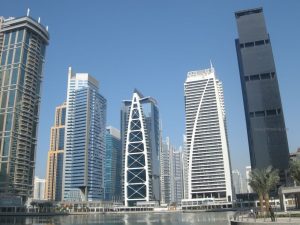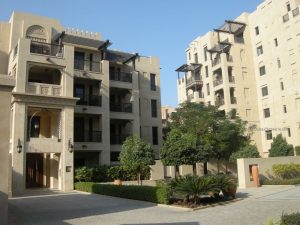• Law no 13 of 2011 was announced with the aim of regulating economic activity and connecting government departments under a single portal in order to streamline commercial activity and investment in the Emirate.
• Prime office lease rates remained unchanged for the fourth straight quarter with rates ranging between AED1,080 to 1,940/sqm/pa;
• Secondary office locations have seen a 11% drop in lease rates year on year.
• The residential market remained stable during the quarter with average lease rates for residential apartments dropping marginally by 2%, while villa rates remained unchanged.
Overview
The year ended with mixed signals for Dubai’s real estate market. Although pockets of stability and even growth were to be found these are still the exception rather than the rule. Oversupply issues remain prevalent with demand fundamentals being outpaced by the completion of new stock.
The UAE remains on solid tracks in its economic recovery as the economy grew by around 4% during 2011. This followed growth of 1.4% in 2010 and the 1.6% contraction in 2009. During 2012 the UAE is again expected to reach 4.0% growth, with Dubai likely to post similar performance.
A more positive mood was also reflected in the Consumer Confidence Index (CCI) from the Department of Economic Development (DED) which rose 15 points to 125 during the final quarter. Respondents were most optimistic about the economic recovery, personal finances and job creation, although escalating food prices were still highlighted as a concern.
The Business Confidence Index (BCI) from the DED also suggested a recovery of fortunes. The index rose 16% during the final three months of the year as a positive outlook on trade and SME’s helped to lift expectations for future performance.
The Dubai Government announced the introduction of ‘Law no 13 of 2011’ in an effort to boost business confidence and attract new investment to the real estate market. The amended commercial law aims to create a more transparent, efficient and competitive environment by streamlining the process for business licenses and permits through the DED. The new legislation will also look to strengthen intellectual property rights and regulations, and intensify the fight against commercial fraud.
More life was evident within the Emirate’s residential sector as increased activity over the quarter was highlighted in Dubai Land Department data. The total number of residential sales during Q4, 2011 reached 2,605 as compared to just 1,589 transactions in Q3. This represented a 64% increase quarter on quarter. During the same period, around 300,000 square metres of residential accommodation was sold at an average rate of AED9,500/sqm. This represents 5% growth year on year.
In value terms, the overall real estate market increase was less striking at just 6% growth, with total transactions increased from AED2.7 billion in Q3 to AED2.85 billion in Q4. Compared to Q4 2010, the increased value of transactions was significant, rising 67% from AED1.7 billion to AED2.85 billion.
Office Market
 Prime (CBD) office rents have now remained unchanged for four straight quarters. Lease rates during Q4 ranged between AED1,080 to 1,940/sqm/pa inclusive of service charges (office service charges typically range between AED160 to 270/sqm/pa depending on the development).
Prime (CBD) office rents have now remained unchanged for four straight quarters. Lease rates during Q4 ranged between AED1,080 to 1,940/sqm/pa inclusive of service charges (office service charges typically range between AED160 to 270/sqm/pa depending on the development).
Occupiers continue to seek a flight to quality, which has resulted in prime CBD offices outperforming the wider real estate market over the past year.
Office accommodation in the CBD currently represents 13% of total Dubai stock, with vacancy rates hovering around 15%, a figure significantly lower than the market average. During the year, close to 58,000 square metres of new office space entered the CBD, which has added a little more pressure to vacancy rates but was not sufficient to impact rents.
Despite static lease rate movement, landlords do now appear more open to incentivising deals as they seek to avoid rising vacancy rates and maintain their headline rents. Extended rent-free periods of between three and six months, and in a few cases even up to twelve months, can now be achieved when negotiating on longer lease tenures.
The majority of office activity over the past year may be categorised largely as churn, with relocations, expansions and consolidations of space, rather than demand generated from new real estate market entrants.
Secondary Office Market
The stress on secondary office locations continues with lease and occupancy rates sliding on excessive supply. Average lease rates during Q4, 2011 ranged from AED430 to AED1,400/sqm/pa as compared to AED3,130/sqm/pa during the peak. During 2011, lease rates in secondary locations dropped by 11%, faring better than 2010 wherein the drop was 30%.
Ongoing construction activity and ownership status in the majority of secondary office locations is having a negative impact on lease and occupancy rates. Although the lease rates have not changed during the last six months, the vacancy rates have elongated as a result of new office space coming to the market. This trend is likely to continue in the near future as further office towers are expected to come on line during 2012, further elevating vacancy rates.
Residential Market
 The residential market continued to show signs of increased stability, although average lease rates were dragged down by apartments which fell 2% during the quarter. However, villa rates remained unchanged reflecting the relative strength of that segment.
The residential market continued to show signs of increased stability, although average lease rates were dragged down by apartments which fell 2% during the quarter. However, villa rates remained unchanged reflecting the relative strength of that segment.
The 2% fall in apartment rents was primarily attributed to continued deflationary pressures within secondary locations such as International City, Dubai Silicon Oasis and Dubailand Residences. The majority of other areas experienced little movement, although some prime locations posted modest growth.
Investor interest in residential property continues to increase, with concentration on established community projects that offer superior facilities and amenities.
A similar situation is apparent in the occupational market as tenants seek out lifestyle developments aligned with their aspirations. This has resulted in high demand and rising occupancy rates for some areas in Emirates Living, Downtown, Dubai Marina and Palm Jumeirah.
The Dubai market has become very fractional with end user focus now becoming project- and even building-specific within any given area. The quality of facilities, accessibility, property management and maintenance, are all factors together with traditional drivers of quality, price and location. Less attention is being directed towards masterplanned schemes such as Business Bay and Dubailand which remain hindered by infrastructure issues.
Average apartment lease rates fell by 8% during 2011, compared to 17% in 2010. Much of the decline during the year was actually for studio units which fell by 11% year on year. The smallest fall was the 5% recorded for three bedroom units. Lease rates in older residential districts remained unchanged during the quarter as the opening of The Green Line helped to stabilise rents. Properties within 500 metres of operational metro stations have experienced improved occupancy levels as tenants target accommodation with strong transport links.
Villas and townhouses have significantly outperformed apartments during the year. A more limited supply of units and stronger demand fundamentals saw rents decline just 6% over the period, less than half of the fall registered during 2010. The biggest fall was for two bedroom units which registered a 17% decline due to more abundant availability and the end users heightened ability to upsize. The average annual lease rate for a two bedroom unit in Q4, 2010 was AED96,000/unit. This has since dropped to AED80,000/unit as of the end Q4, 2011.
Outlook
With a vast development pipeline scheduled for completion over the next 12 months, it is expected commercial offices to remain under duress throughout 2012. Around 750,000 sq m of new stock could enter the supply during the period, provided that construction delays are kept to a minimum. The majority of this space is strata owned. New supply will emanate predominantly from secondary and tertiary locations including Business Bay, Jumeirah Lakes Towers and Dubai Investment Park, which are already experiencing very low lease and occupancy rates.
Lease rates in the CBD are expected to remain quite stable during 2012. However, the real estate market market will see landlord incentives increase as new supply is completed and competition to secure tenancies intensifies. Secondary and tertiary markets will see further elevation of vacancy rates and some modest declines in rents.
The residential sector will continue to outperform offices as stronger demand fundamentals are sustained by solid population growth. Developments with completed infrastructure and community facilities will again attract the majority of interest, particularly within the Emirate’s more popular ‘lifestyle’ projects.























![The Square at Nad Al Sheba Gardens Now Open hope tax season treated you well! Just checking in—ready to refocus on growing your business? I remember how we discussed scaling your [specific aspect of their business, e.g., online presence] but paused due to time constraints. We now offer a streamlined 6-month plan that delivers real results without adding to your workload. Let me know if you'd like to chat—I’d love to help you pick up where we left off!](https://www.dubaichronicle.com/wp-content/uploads/2024/11/The-Square-5-218x150.jpg)








